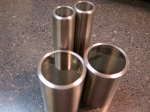SOLUTIONS & SERVICES
Solutions & Services
Ceramic to Metal Bonding
S-Bond® active solders enable the joining of ceramics, such as oxides, nitrides, carbides, carbon/graphite silicides, and others, to metals. S-Bond alloys have active elements such as titanium and cerium added to Sn-Ag, Sn-In-Ag, and Sn-Bi alloys to create a solder that can be reacted directly with the ceramic and sapphire surfaces prior to bonding. S-Bond alloys produce reliable, hermetic joints with all metals…including steel, stainless steels, titanium, nickel alloys, copper and aluminum alloys, provided thermal expansion mismatch at joining temperatures is managed.

S-Bond® active solders enable ceramic to metal bonding and sapphire to metal bonding as well as to each other. S-Bond alloys have active elements such as titanium and cerium added to Sn-Ag, Sn-In-Ag, and Sn-Bi alloys to create a solder that can be reacted directly with the ceramic and sapphire surfaces prior to bonding. S-Bond alloys produce reliable, hermetic joints with all metals…including steel, stainless steels, titanium, nickel alloys, copper and aluminum alloys
Advantages of S-Bond® Ceramic/Metal bonding
- Lowers joining temperatures compared to conventional active brazing.
- Permits larger and more complex assemblies to be fabricated without ceramic cracking.
- Does not require plating of sapphire or the metal in the assemblies.
- Increases process yields related to joint failures from poor metallization layers.
- Lowers joining costs with reduced steps
- Eliminates clean-up of flux residue
- Produces a reworkable joint that can be taken apart and reliably joined again
Need more information on ceramic to metal bonding? We have a white paper on this topic: Joining of Sapphire and Ceramics to Metals.
More Information?
If you would like someone to contact you or provide information, please submit the information to the right.
